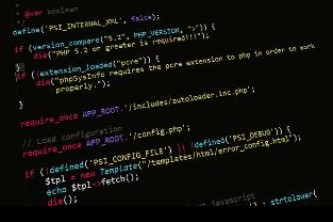使用Node.js读取JSON文件的实用指南
在Node.js开发中,处理JSON数据是一项常见任务,无论是读取配置文件、解析API响应,还是处理数据存储,如何高效读取JSON文件都是必备技能,本文将详细介绍几种在Node.js中读取JSON文件的方法,从基础到进阶,帮助你应对各种开发场景。
使用fs模块同步读取JSON文件
Node.js内置的fs模块提供了文件操作的基础功能,对于简单的JSON读取需求,可以使用同步方法:
const fs = require('fs');
const path = require('path');
// 同步读取JSON文件
function readJsonFileSync(filePath) {
try {
const absolutePath = path.resolve(filePath);
const fileData = fs.readFileSync(absolutePath, 'utf8');
return JSON.parse(fileData);
} catch (error) {
console.error('读取JSON文件失败:', error);
return null;
}
}
// 使用示例
const config = readJsonFileSync('./config.json');
console.log(config);
优点:
- 代码简单直观
- 适合小型应用或一次性读取操作
缺点:
- 阻塞主线程,不适合大文件或高频读取场景
使用fs模块异步读取JSON文件
对于生产环境,推荐使用异步方法避免阻塞事件循环:
const fs = require('fs').promises; // 使用Promise API
const path = require('path');
// 异步读取JSON文件
async function readJsonFileAsync(filePath) {
try {
const absolutePath = path.resolve(filePath);
const fileData = await fs.readFile(absolutePath, 'utf8');
return JSON.parse(fileData);
} catch (error) {
console.error('读取JSON文件失败:', error);
return null;
}
}
// 使用示例
(async () => {
const data = await readJsonFileAsync('./data.json');
console.log(data);
})();
优点:
- 非阻塞,适合高并发场景
- 更好的错误处理机制
使用第三方库简化操作
虽然Node.js内置了fs模块,但第三方库可以提供更简洁的API:
使用jsonfile库
npm install jsonfile
const jsonfile = require('jsonfile');
// 异步读取
jsonfile.readFile('./package.json', (err, data) => {
if (err) console.error(err);
console.log(data);
});
// 同步读取
try {
const data = jsonfile.readFileSync('./package.json');
console.log(data);
} catch (err) {
console.error(err);
}
使用fs-extra库
npm install fs-extra
const fs = require('fs-extra');
// 异步读取
fs.readJson('./config.json')
.then(data => console.log(data))
.catch(err => console.error(err));
// 同步读取
try {
const data = fs.readJsonSync('./config.json');
console.log(data);
} catch (err) {
console.error(err);
}
优点:
- API更简洁
- 提供更好的错误处理
- 支持更多文件系统操作
最佳实践与注意事项
- 路径处理:始终使用
path.resolve()或path.join()处理文件路径,避免跨平台问题 - 错误处理:始终包裹JSON解析操作,避免因格式错误导致程序崩溃
- 性能考虑:对于频繁读取的JSON文件,考虑实现缓存机制
- 数据验证:读取后验证JSON数据结构是否符合预期
// 带验证的JSON读取示例
async function readAndValidateJson(filePath, schema) {
try {
const data = await readJsonFileAsync(filePath);
// 这里可以添加schema验证逻辑
return data;
} catch (error) {
console.error('JSON读取或验证失败:', error);
return null;
}
}
实际应用场景
-
配置文件读取:读取应用配置
const config = await readJsonFileAsync('./config/app.json'); -
多语言支持:加载语言包
const translations = await readJsonFileAsync(`./locales/${language}.json`); -
数据导入:批量处理JSON数据
const dataset = await readJsonFileAsync('./data/large-dataset.json');
在Node.js中读取JSON文件有多种方法选择:
- 对于简单脚本,同步方法足够使用
- 对于生产环境,异步方法是更好的选择
- 第三方库如
jsonfile和fs-extra可以简化开发流程
根据项目需求选择合适的方法,并注意错误处理和性能优化,能够帮助你更高效地处理JSON数据,随着Node.js版本的更新,新的API和最佳实践也会不断涌现,保持学习是提升开发能力的关键。







还没有评论,来说两句吧...